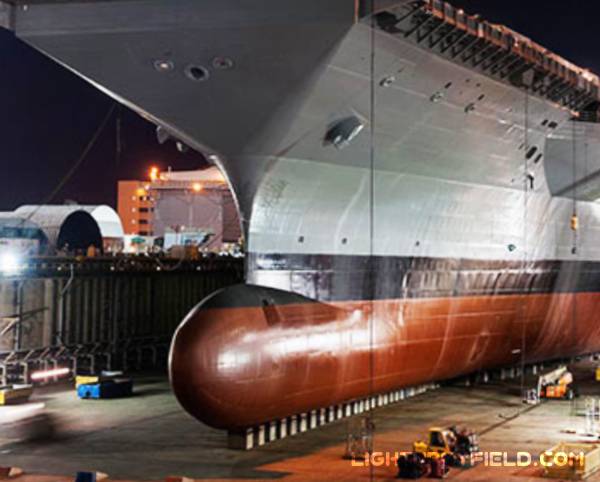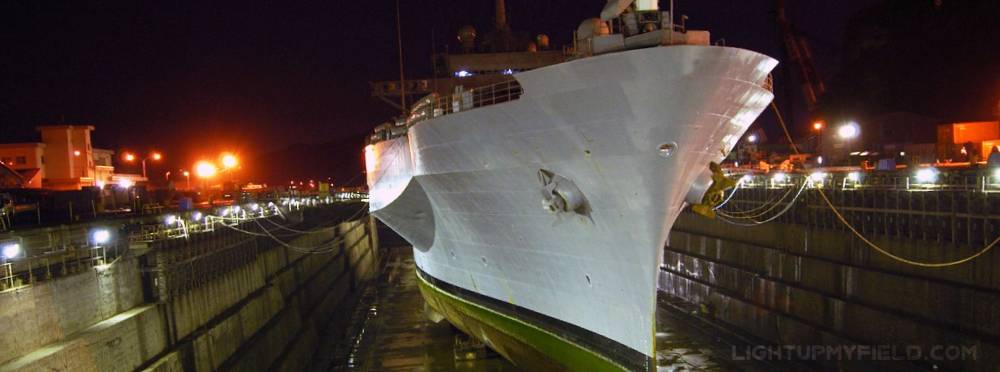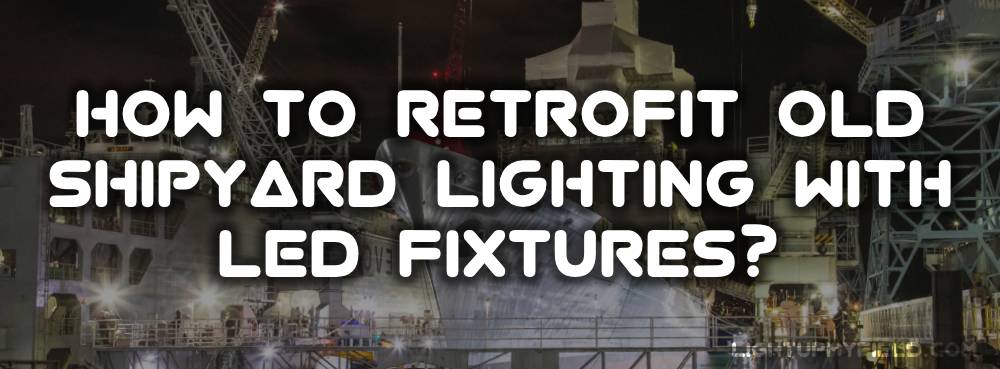Shipyards run almost around the clock, and that means lighting plays a huge role in how safe and efficient the work gets done. If you’re still running those old metal halide or high-pressure sodium fixtures, chances are you’ve already felt the pain of high energy bills, frequent maintenance, and less-than-great visibility. That’s where retrofitting with LED fixtures comes into the picture.
Making the switch isn’t just a trend; it’s a move that can completely change how your shipyard operates at night or during low-light conditions. So, what does a retrofit really involve, and why should you even consider doing it? Let’s break it down.
Table of Contents
ToggleWhy Do We Need to Retrofit?
Switching from old-school lighting to LEDs isn’t just some trendy move—it actually makes a lot of sense for shipyards, both financially and operationally. Let’s talk about why so many yards are making the change and what you stand to gain.
Massive Energy Savings
 The biggest reason? Energy costs. Traditional high-intensity discharge (HID) lamps, like metal halide or high-pressure sodium, eat up electricity like there’s no tomorrow. A single 1000-watt metal halide fixture running for 12 hours a day uses 12 kWh daily. That’s about 360 kWh a month—or 4,380 kWh in a year. Multiply that by 100 fixtures (which isn’t unusual in a large shipyard), and you’re staring at 438,000 kWh annually. At an average rate of $0.12 per kWh, that’s over $52,000 per year just for lighting.
The biggest reason? Energy costs. Traditional high-intensity discharge (HID) lamps, like metal halide or high-pressure sodium, eat up electricity like there’s no tomorrow. A single 1000-watt metal halide fixture running for 12 hours a day uses 12 kWh daily. That’s about 360 kWh a month—or 4,380 kWh in a year. Multiply that by 100 fixtures (which isn’t unusual in a large shipyard), and you’re staring at 438,000 kWh annually. At an average rate of $0.12 per kWh, that’s over $52,000 per year just for lighting.
Now, here’s where LEDs flip the script. If you replace those 1000W metal halides with 500W LED fixtures, you instantly cut consumption by half. So instead of 438,000 kWh, you’re using about 219,000 kWh, which drops the bill to roughly $26,000 a year. That’s a $26,000 annual saving, and that’s just from electricity alone—not counting maintenance costs. In some shipyards, the savings are even bigger because LEDs often let you use fewer fixtures for the same brightness.
Less Maintenance, Less Hassle
If you’ve ever had to schedule maintenance for high mast poles, you know it’s not a quick job. Old HID lamps typically last 12,000 to 20,000 hours. If your lights run 4,000 hours a year (pretty standard for a yard that runs nights and weekends), you’ll need to replace them every 3 to 5 years. Factor in the cost of new bulbs, labor, and renting equipment like lifts or cranes, and you’re easily spending thousands every time.
LEDs change the game here. Many modern LED fixtures have a rated lifespan of 50,000 to 100,000 hours. At 4,000 hours per year, that’s 12 to 25 years before you even think about replacements. That’s a huge relief for maintenance crews and a big cost saver for you.
Better Visibility for Safer Work
Lighting isn’t just about brightness; it’s about clarity. LEDs produce a crisp, white light that makes details pop, unlike the yellowish or bluish tint of older lamps. The difference this makes in a busy shipyard is huge. For example, if you’re loading cargo at night or doing welding work, being able to see surfaces clearly can prevent accidents. Studies suggest that improved lighting can reduce workplace incidents by up to 30%, which means better safety and fewer delays caused by mishaps.
Sustainability Goals Made Simple
These days, energy efficiency isn’t just a nice-to-have—it’s often tied to company sustainability goals. Cutting your energy use by 50-70% instantly reduces your carbon footprint. Some shipyards even use LED retrofits to qualify for green certifications or meet ISO environmental standards. Plus, many utilities offer rebates for switching to LEDs, which can lower your upfront cost and make the ROI happen even faster.

Steps to Retrofit Old Shipyard Lighting
Retrofitting might sound like a huge job, but with the right game plan, it’s way more manageable than tearing everything down and starting from scratch. Most projects follow a few key stages that make the process smoother.
Take Stock of What You Have
Before you start shopping for LEDs, you need a clear picture of your current setup. How tall are your poles—20 meters? 30 meters? How many fixtures sit on each one? What’s the wattage of those old lamps? For example, if you’re using 1000W metal halide fixtures, and each pole has eight of them, that’s 8,000 watts per pole. Multiply that by 20 poles and you’re burning 160,000 watts when everything’s on.
Don’t forget to check wiring and control systems too. Many older shipyards have electrical systems that haven’t seen an update in decades, so part of your retrofit might include replacing old wiring or upgrading control panels. That’s not the fun part, but skipping it can lead to headaches later.
Redesign Instead of Copy-Pasting
A common mistake is thinking you can just swap old lights for LEDs one-to-one. LEDs don’t work like that—they’re more efficient and distribute light differently. A single 600W LED fixture can easily replace a 1000W metal halide while delivering better light quality. Sometimes you can even reduce the total number of fixtures by 15–30% and still maintain or improve brightness.
This is where a lighting design comes in. Use simulation software or hire a designer to ensure the new layout meets the lux levels your yard needs. Heavy assembly zones might need 150 lux or more, while open storage areas can work fine with 50–100 lux. Planning this step carefully helps you avoid dark spots, glare, and wasted energy.
Pick the Right LED Fixtures
Once the design’s locked in, it’s time to choose your LEDs. High mast floodlights usually range from 300W to 1200W, pumping out anywhere from 40,000 to 150,000 lumens. For shipyards, fixtures with a 60° to 90° beam angle usually hit the sweet spot, giving wide coverage without too much spill.
Check the ratings—this is non-negotiable. You’ll want an IP65 rating or higher to survive salty sea air, dust, and heavy rain. And don’t ignore the Color Rendering Index (CRI). Go for at least 70 or higher, so colors look natural. This matters more than you think—workers need to distinguish between paint marks, wiring, or defects quickly.
Inspect Poles and Hardware
Here’s where a lot of retrofits hit a snag. Just because your poles have been standing for 20 years doesn’t mean they’re ready for another 20. Inspect for corrosion, cracks, and structural weakness. While LEDs are often lighter than old HID fixtures, you still need to factor in wind loads. If you’re in a coastal area where storms bring winds of 120 km/h or more, your poles need to handle that pressure without flexing or toppling. In some cases, reinforcing the base or replacing old poles is the safest call.
Installation and Testing
Finally, the fun part—getting the new lights up. Most shipyards do this in phases so work doesn’t grind to a halt. Once installation is complete, test everything. Measure light levels to make sure you hit the design target, check uniformity across key areas, and watch out for glare. Glare can be dangerous, especially for crane operators or drivers moving heavy equipment. A quick lighting audit after installation can save you from expensive do-overs later.
Tips to Retrofit Old Shipyard Lighting
Even with a solid design in place, a few practical tips can make the entire retrofit process a lot smoother and help you avoid expensive mistakes down the road.
Think About Controls From the Start
Smart lighting controls aren’t just a fancy extra anymore—they can seriously cut operating costs. Features like dimming, motion sensors, and scheduling timers can easily shave another 20–30% off your energy use. Imagine a shipyard running 100 LED fixtures at 500 watts each. That’s 50 kilowatts per hour when everything’s on. If controls help you cut usage by just 25%, you’re saving 12.5 kilowatts per hour. Over 12 hours a day and 365 days a year, that’s more than 54,000 kWh saved annually, which translates into thousands of dollars.
The key here is to plan for these controls during the design phase, not as an afterthought. Retro-fitting controls later can mean extra wiring, downtime, and costs that you could have avoided.
Don’t Skimp on Fixture Quality
It’s tempting to go for the cheapest LEDs to keep upfront costs low, but that move usually backfires. Lower-quality LEDs might promise 50,000 hours but often start losing brightness way earlier—or worse, fail outright. A solid LED fixture should realistically give you 50,000 to 100,000 hours of life and come with a minimum 5-year warranty. The difference between a budget fixture and a premium one might be a few hundred dollars upfront, but when you factor in maintenance, replacements, and labor costs, the good stuff almost always pays off.
Think of it this way: if a fixture fails at 20,000 hours, replacing it means hiring a crew, possibly renting a lift or crane, and interrupting work. That’s a lot more expensive than the extra $100–200 you saved on the initial purchase.
Prepare for Harsh Environments
Shipyards aren’t gentle places. You’ve got salt spray in the air, constant vibration from heavy equipment, and temperatures that can swing from freezing winters to scorching summers. Not every light can survive that. Look for corrosion-resistant housings—marine-grade coatings are a big plus. Make sure the fixture has an IP65 or IP66 rating so it’s fully sealed against water and dust.
Impact resistance matters too. LEDs installed on high masts can face wind-borne debris during storms. Fixtures rated for IK08 or higher will give you extra peace of mind. Cutting corners on this is like saving on cheap tires for a truck—they might work for a while, but when they fail, it’s usually at the worst possible time.
Keep Your Crew in Mind
Lighting isn’t just about raw brightness; it’s about visibility and comfort. Overly bright lights can create glare that blinds crane operators or truck drivers. On the flip side, uneven lighting can create harsh shadows that hide hazards on the ground. Neither is good when you’re moving multi-ton loads around.
If you can, run a pilot installation in a small section of the yard and get feedback from the people who work there every day. Ask if they notice glare, dark spots, or color issues. A little feedback upfront can prevent a lot of headaches after full deployment.
Making the Switch Pays Off
Retrofitting your old shipyard lighting system to LEDs might feel like a big project, but the payoff is huge. Lower energy bills, fewer maintenance headaches, and better working conditions are just the start. Many shipyards see a return on investment in 2 to 4 years, thanks to the savings and efficiency gains. Plus, with the right design and fixtures, you’re setting your yard up for safer, more productive nights for years to come.

